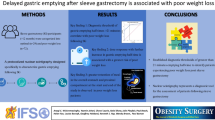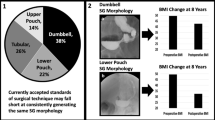Abstract
Background
This prospective study applied magnetic resonance imaging (MRI) to assess the effect of laparoscopic sleeve gastrectomy (LSG) on gastric structure and function. The impact of these changes on patient outcomes was analyzed.
Method
Obese patients without gastrointestinal symptoms referred for bariatric surgery were recruited prospectively. Pre-operative assessment included (i) high-resolution manometry and pH-impedance monitoring and (ii) magnetic resonance imaging (MRI) measurement of gastric capacity, accommodation, and emptying with the 400 ml liquid Nottingham test meal (NTM). Studies were repeated 6–7 months after LSG. Weight loss and changes in the Gastrointestinal Quality of Life Index (GIQLI) assessed patient outcomes.
Results
From 35 patients screened, 23 (66%) completed the study (17 females, age 36 ± 10 years, BMI 42 ± 5 kg/m2). Mean excess weight loss was 59 ± 18% at follow-up. Total gastric volume (capacity) after the meal was 467 mL (455–585 ml) before and 139 mL (121–185 ml) after LSG (normal reference 534 (419–675) mL), representing a mean 70% reduction (p < 0.0001). Similar findings were present for gastric content volume indicating rapid early-phase gastric emptying (GE) post-LSG. Conversely, late-phase GE was slower post-LSG (2.5 ± 1.0 vs. 1.4 ± 0.6 mL/min; p < 0.0001; (reference 1.5(1.4–4.9) mL/min)). Patients with ≥ 80% reduction in gastric capacity had greater weight loss (p = 0.008), but worse gastrointestinal outcomes (p = 0.023).
Conclusions
MRI studies quantified the marked reduction in gastric capacity after LSG. The reduction in capacity was associated with rapid early- but slow late-phase GE after surgery. These changes were associated with weight loss; however, reductions in gastric capacity ≥ 80% were linked to increased acid reflux and impacted on gastrointestinal quality of life.




Similar content being viewed by others
Notes
The increase in TGV after a liquid test meal is often less than the volume ingested because the rate of early-phase GE is greater than the rate of secretion.
References
Welbourn R, Hollyman M, Kinsman R, et al. Bariatric surgery worldwide: baseline demographic description and one-year outcomes from the Fourth IFSO Global Registry Report. Obes Surg. 2018:2019.
Angrisani L, Santonicola A, Iovino P, et al. Bariatric Surgery Worldwide. Obes Surg. 2013:2015.
Peterli R, Wölnerhanssen BK, Peters T, et al. Effect of laparoscopic sleeve gastrectomy vs laparoscopic Roux-en-Y gastric bypass on weight loss in patients with morbid obesity. Jama. 2018;319:255. https://doi.org/10.1001/jama.2017.20897.
Yehoshua RT, Eidelman LA, Stein M, et al. Laparoscopic sleeve gastrectomy - volume and pressure assessment. Obes Surg. 2008;18:1083–8.
Baumann T, Kuesters S, Grueneberger J, et al. Time-resolved MRI after ingestion of liquids reveals motility changes after laparoscopic sleeve gastrectomy-preliminary results. Obes Surg. 2011;21:95–101.
Bernstine H, Tzioni-Yehoshua R, Groshar D, et al. Gastric emptying is not affected by sleeve gastrectomy-scintigraphic evaluation of gastric emptying after sleeve gastrectomy without removal of the gastric antrum. Obes Surg. 2009;19:293–8.
Braghetto I, Davanzo C, Korn O, et al. Scintigraphic evaluation of gastric emptying in obese patients submitted to sleeve gastrectomy compared to normal subjects. Obes Surg. 2009;
Shah S, Shah P, Todkar J, et al. Prospective controlled study of effect of laparoscopic sleeve gastrectomy on small bowel transit time and gastric emptying half-time in morbidly obese patients with type 2 diabetes mellitus. Surg Obes Relat Dis. 2010;
Garay M, Balagué C, Rodríguez-otero C, Gonzalo B, Domenech A, Pernas JC, et al. Influence of antrum size on gastric emptying and weight-loss outcomes after laparoscopic sleeve gastrectomy (preliminary analysis of a randomized trial). Surg Endosc. Springer US; 123AD;0:0. https://doi.org/10.1007/s00464-017-5972-4
Melissas J, Leventi A, Klinaki I, et al. Alterations of global gastrointestinal motility after sleeve gastrectomy: a prospective study. Ann Surg. 2013;258:976–82.
Pilone V, Tramontano S, Di Micco R, et al. Gastric emptying after sleeve gastrectomy: statistical evidence of a controlled prospective study with gastric scintigraphy. Minerva Chir. 2013;
Azpiroz F, Feinle-Bisset C, Grundy D, et al. Gastric sensitivity and reflexes: basic mechanisms underlying clinical problems. J Gastroenterol. 2014;49:206–18.
Grundy SM, Barondess JA, Bellegie NJ, et al. Gastrointestinal surgery for severe obesity. Ann Intern Med. 1991;
Fiorillo C, Quero G, Vix M, et al. 6-Month Gastrointestinal Quality of Life (QoL) Results after endoscopic sleeve gastroplasty and laparoscopic sleeve gastrectomy: a propensity score analysis. Obes Surg. 2020; https://doi.org/10.1007/s11695-020-04419-1.
Quero G, Fiorillo C, Dallemagne B, et al. The causes of gastroesophageal reflux after laparoscopic sleeve gastrectomy: quantitative assessment of the structure and function of the esophagogastric junction by magnetic resonance imaging and high-resolution manometry. Obes Surg. 2020;30:2108–17.
Fuchs KH, Babic B, Breithaupt W, Dallemagne B, Fingerhut A, Furnee E, et al. EAES recommendations for the management of gastroesophageal reflux disease. Surg Endosc. 2014;
Kahrilas PJ, Bredenoord AJ, Fox M, et al. The Chicago Classification of Esophageal Motility Disorders v3.0. Neurogastroenterol Motil. 2016;
Gyawali CP, Kahrilas PJ, Savarino E, Zerbib F, Mion F, Smout AJPM, et al. Modern diagnosis of GERD: the Lyon Consensus. Gut [Internet]. 2018;gutjnl-2017-314722. Available from: https://doi.org/10.1136/gutjnl-2017-314722, 2018
Prakash Gyawali C, Kahrilas PJ, Savarino E, et al. Modern diagnosis of GERD: the Lyon Consensus. Gut. 2018;
Curcic J, Fox M, Kaufman E, et al. Gastroesophageal junction: structure and function as assessed by using MR imaging. Radiology. 2010;257:115–24.
Parker H, Hoad CL, Tucker E, et al. Gastric motor and sensory function in health assessed by magnetic resonance imaging: establishment of reference intervals for the Nottingham test meal in healthy subjects. Neurogastroenterol Motil. 2018;30:e13463.
Parker HL, Tucker E, Hoad CL, et al. Development and validation of a large, modular test meal with liquid and solid components for assessment of gastric motor and sensory function by non-invasive imaging. Neurogastroenterol Motil. 2016;
Kwiatek MA, Menne D, Steingoetter A, et al. Effect of meal volume and calorie load on postprandial gastric function and emptying: studies under physiological conditions by combined fiber-optic pressure measurement and MRI. Am J Physiol - Gastrointest Liver Physiol. 2009;297:G894–901.
Schwizer W, Steingoetter A, Fox M. Magnetic resonance imaging for the assessment of gastrointestinal function. Scand J Gastroenterol. 2006;41:1245–60.
Braghetto I, Cortes C, Herquiñigo D, et al. Evaluation of the radiological gastric capacity and evolution of the BMI 2-3 years after sleeve gastrectomy. Obes Surg. 2009;19:1262–9.
Alvarez V, Carrasco F, Cuevas A, et al. Ghiardo D, et al. Nutrition: Mechanisms of long-term weight regain in patients undergoing sleeve gastrectomy; 2016.
Hanssen A, Plotnikov S, Acosta G, et al. 3D Volumetry and its correlation between postoperative gastric volume and excess weight loss after sleeve gastrectomy. Obes Surg. 2018;28:775–80.
Kwiatek MA, Fox MR, Steingoetter A, et al. Effects of clonidine and sumatriptan on postprandial gastric volume response, antral contraction waves and emptying: an MRI study. Neurogastroenterol Motil. 2009;21:928–e71.
Tucker E, Parker H, Hoad C, et al. PWE-048 gastric volume response and emptying after a large liquid nutrient meal in functional dyspepsia and health assessed by non-invasive gastric scintigraphy (GS) and MRI: a pilot study to identify candidate biomarkers. Gut. 2012;61:A316.1–A316.
Fox M, Georgi G, Boehm G, et al. Thumshirn M. Clin Nutr: Dietary protein precipitation properties have effects on gastric emptying in healthy volunteers; 2004.
Marciani L, Hall N, Pritchard SE, et al. Preventing gastric sieving by blending a solid/water meal enhances satiation in healthy humans. J Nutr. 2012;
Steingoetter A, Radovic T, Buetikofer S, et al. Imaging gastric structuring of lipid emulsions and its effect on gastrointestinal function: a randomized trial in healthy subjects. Am J Clin Nutr. 2015;101:714–24.
Mans E, Serra-Prat M, Palomera E, et al. Sleeve gastrectomy effects on hunger, satiation, and gastrointestinal hormone and motility responses after a liquid meal test1. Am J Clin Nutr. 2015;102:540–7.
Braghetto I, Lanzarini E, Korn O, et al. Manometric changes of the lower esophageal sphincter after sleeve gastrectomy in obese patients. Obes Surg. 2010;
Burgerhart JS, Schotborgh CAI, Schoon EJ, et al. Effect of sleeve gastrectomy on gastroesophageal reflux. Obes Surg. 2014;
Strain GW, Saif T, Gagner M, et al. Cross-sectional review of effects of laparoscopic sleeve gastrectomy at 1, 3, and 5 years. Surg Obes Relat Dis. 2011;7:714–9.
Baltasar A, Serra C, Pérez N, et al. Laparoscopic sleeve gastrectomy: a multi-purpose bariatric operation. Obes Surg. 2005;15:1124–8.
Melissas J, Koukouraki S, Askoxylakis J, Stathaki M, Daskalakis M, Perisinakis K, et al. Sleeve gastrectomy - a restrictive procedure? Obes Surg. 2007;
Obeidat FW, Shanti HA, Mismar AA, et al. Volume of resected stomach as a predictor of excess weight loss after sleeve gastrectomy. Obes Surg. 2014;
Papamargaritis D, Le Roux CW, Sioka E, Koukoulis G, Tzovaras G, Zacharoulis D. Changes in gut hormone profile and glucose homeostasis after laparoscopic sleeve gastrectomy. Surg Obes Relat Dis. 2013;
Svane MS, Bojsen-Møller KN, Martinussen C, et al. Postprandial nutrient handling and gastrointestinal hormone secretion after Roux-en-Y gastric bypass vs sleeve gastrectomy. Gastroenterology. 2019;
Riccioppo D, Santo MA, Rocha M, et al. Small-volume, fast-emptying gastric pouch leads to better long-term weight loss and food tolerance after Roux-en-Y gastric bypass. Obes Surg. 2018;
Author information
Authors and Affiliations
Corresponding author
Ethics declarations
Conflict of Interest
The authors declare that they have no conflict of interest.
Ethical Approval
All procedures performed in studies involving human participants were in accordance with the ethical standards of the institutional and national research committee and with the 1964 Helsinki declaration and its later amendments or comparable ethical standards.
Informed Consent
Informed consent was obtained from all individual participants included in the study.
Additional information
Publisher’s Note
Springer Nature remains neutral with regard to jurisdictional claims in published maps and institutional affiliations.
Electronic supplementary material
ESM 1
(TIFF 40.4 kb)
Rights and permissions
About this article
Cite this article
Fiorillo, C., Quero, G., Dallemagne, B. et al. Effects of Laparoscopic Sleeve Gastrectomy on Gastric Structure and Function Documented by Magnetic Resonance Imaging Are Strongly Associated with Post-operative Weight Loss and Quality of Life: a Prospective Study. OBES SURG 30, 4741–4750 (2020). https://doi.org/10.1007/s11695-020-04831-7
Received:
Revised:
Accepted:
Published:
Issue Date:
DOI: https://doi.org/10.1007/s11695-020-04831-7




